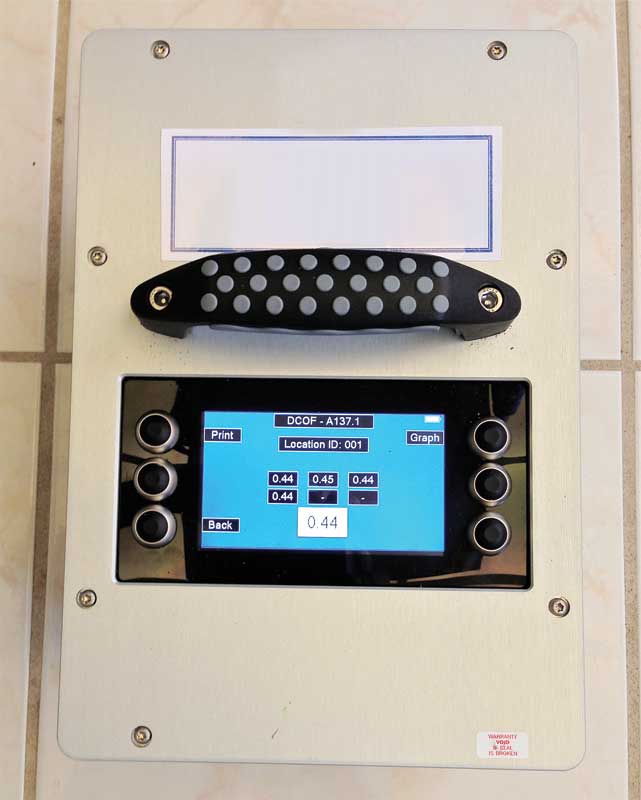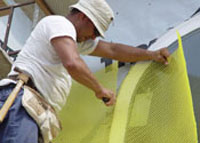The new slip resistance requirements in IBC

However, neither ANSI nor TCNA give any method of evaluating any or all of these variables. So what is a specifier to do? Slip and fall awards can at times far exceed $1 million in cases where, for instance, someone incurs brain damage and must be supported for life. For this and other general reasons of good practice and respect for safety, it behooves the specifier not to be negligent in setting slip resistance requirements. Negligence is the key word in litigation.
Slip resistance testing can be conducted in the laboratory or in the field, the latter of which may be required by some municipal building inspectors. The DCOF is not always what the manufacturer lists, since it may have been tested years before when raw materials and manufacturing conditions were different.
It is best for all concerned when the proper slip resistance is dictated by a legitimate and legally defensible specification and testing. After all, no one wants the headache of remediating the situation after installing the wrong flooring.
The ANSI A137.1 slip resistance test is conducted using only the BOT-3000E digital tribometer—a relatively recent slip test device made in the United States and backed up by human traction research carried out in Germany. However, it has no situation-specific safety standards (e.g. 0.42, 0.60, 0.80, etc.) for various circumstances.
What’s a specifier to do?
Fortunately, there are detailed situation-specific recommendations in Standards Australia (SA) HB 198:2014, Guide to the Specification and Testing of Slip Resistance of Pedestrian Surfaces, which has been in use Down Under, with minor modifications, since 1999. The authors believe this provides the best justification for a specifier to set guidelines.
The Australian standard uses a different instrument—the pendulum skid tester, which has been in use continuously for pedestrian slip resistance since 1970, and is now a national standard in at least 49 nations. (This is thanks to European Standard EN 13036-4, Road and Airfield Surface Characteristic–Test methods Part 4: Method for Measurement of Slip/Skid Resistance of a Surface: The Pendulum Test). It is employed for ASTM E303, Standard Test Method for Measuring Surface Frictional Properties Using the British Pendulum Tester, and has been endorsed by the Ceramic Tile Institute of America (CTIOA) for all types of flooring since 2001. (See CTIOA’s “Floor Safety Reports: No. 1, Portable Methods” from 2001).
The Australian standard recommends minimum wet pendulum test values (PTVs) for some 40 different situations, such as:
- supermarket aisles (PTV > 12);
- hotel bathrooms and laundries (> 25);
- restrooms (> 35);
- wet treads or landings on stairs (> 45); and
- commercial kitchens or swimming pool ramps and stairs leading into water (> 55).
For reference, the ASTM standard for basketball courts—that is, Section 4.5 of ASTM F2772-11, Standard Specification for Athletic Performance Properties of Indoor Sports Floor Systems—specifies a dry PTV between 80 and 110. (Basketball courts are very slippery when wet, which is why considerable effort is devoted to wiping up sweat off the floor after a player falls.)
The authors believe using the Australian standards indicate a design professional has employed due diligence, best possible practice, and all that is reasonably practicable—in other words, he or she was not negligent. Many of the authors’ domestic and international clients have been using this test method for years in the United States to choose appropriate flooring, due to lack of any similar domestic safety criteria.
If installed flooring is found to have insufficient wet slip resistance, there are ways of remediating it—at least to some extent—in situ. However, safe flooring should really be specified and installed in the first place. Lubricants on indoor floors can include not only tracked-in rainwater and snow, but also spilled beverages, furniture polish, WD40, perfume, cooking oil, and debris (e.g. food, sauces, and dust).



